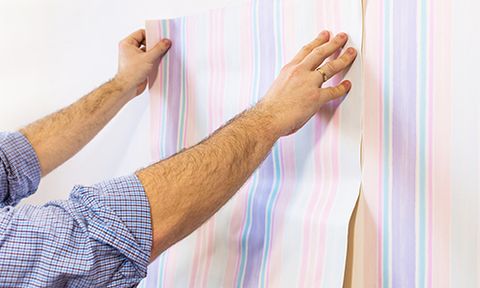Overlap and cut both pieces simultaneously, Reduce the middle of the overlap, Lap one panel over the other, and reduce the middle of the overlap. Angle the knife blade down low so more than simply the pointer of the blade is doing the cutting. Sometimes, rather than butting one panel approximately another, you'll require to produce your own joint.
Bob prefers a 10-in. knife so he doesn't need to move it as often as he would a smaller one. Hold the knife down near the wall to avoid cutting into the ceiling. Make relief cuts prior to trimming, Use a scissors for relief cuts, Use a scissors rather of a knife to prevent accidentally cutting into wood trim and other obstacles.

Task details Ability 3 out of 5 Moderate Not so bad for someone with perseverance and precision, which are essential to hanging paper directly, plumb, and perfectly aligned. Wallpaper initially appeared in the 16th century, in the form of black-and-white hand-blocked prints, and it stays a favorite way to bring color, texture, and character to a home.
See This Report on Regency Wallcraft - Wallcovering Contractor
According to John Dee, these are easier to work with than more fragile and tear-prone plain paper, and normally come pre-pasted, eliminating the need to roll on starch-based adhesives. They can, nevertheless, be more difficult to cut and need bonding with vinyl-to-vinyl adhesive. Suggestion: Silk, yard, cloth, and textured documents likewise require mindful attention throughout installation: "You definitely can't get paste on their faces," Dee states.

Measure the width and height of this wall and mark its midpoint. Cut a brief strip of wallpaper. wallpaper installers near me. Location the dominant element over the midpoint. Mark the wall at the paper's leading edge, the edge against which the next strip will hang. Using a 4-foot level, draw a plumb line at that mark.
To give the adhesive a possibility to trigger, carefully fold over both ends of the strip, being careful not to crease the paper, so that they meet in the middle; this procedure is called "reservation." Make certain the paper's edges are precisely aligned so that no pasted surface area is exposed (need to hang my wallpaper).
Wallpapering 101: Wallpaper Installation - Wayfair - Truths
For pre-pasted paper, loosely roll up a strip with the adhesive side out and immerse it in a trough of cold to lukewarm water, depending upon the maker's directions, simply until the paper is thoroughly wet (however no longer). Book the paper as above for 3 to 5 minutes. Step 4: Hang the First Strip Take the reserved strip to the wall, then unfold and apply the top half, lining up one edge with the plumb line in Step 2.
Overlap a patterned paper as required so that the primary design aspect is focused on the midpoint of the wall section. Initially, smooth the edges of the paper with a wet sponge, then brush gently from the center of the strip to its edges. Next, carefully pull (do not push) a smoother across the paper to eliminate wrinkles and anchor the paper to the wall.
Step, cut, and hang each subsequent strip, sliding them up or down on the wall to align the pattern and to butt joints tightly without any overlaps. Step 6: Wallpaper the Corners Corners are the only locations where strips overlap. For a within corner, measure from the corner to the leading, middle, and bottom of the last-pasted strip.
Fascination About Home - Start Wallpaper - Wallpaper Installation, Wallpaper ...
Using a level, cut a dry strip to that width, cutting the edge that'll fulfill the corner. Hang the paper so the just-cut edge turns the corner and extends onto the surrounding wall. Position the adjoining strip with its edge inside the corner, overlapping the previous strip; line up the patterns.

Utilizing the line as a guide, hang this strip. For outdoors corners, cut the strip to wrap over the next wall by inch. Hang the next strip so it overlaps the previous piece but lands short of the corner. This avoids the paper from peeling if someone brushes versus the corner.
From the paper's waste edge to the corners of the trim, make diagonal cuts with scissors to permit the paper to lay flat on the wall. Eliminate the bulk of the overlap with scissors. Smooth the paper as in Action 4, then use the smoother to press the paper snugly versus the casing, the ceiling, and the baseboard.
Top Guidelines Of Custom Wall Mural Design And Installation - Speedpro
Step 8: Cut Around Window Apron To cut around a window's stool and apron, make a series of routes from the waste edge of the strip towards the corner where wall and stool satisfy. These narrow fingers of paper permit the strip to be shaped to the profile of the casing.
Get step-by-step directions on how to hang embossed and basic wallpaper - local wallpaper hangers.
• you could look hereotheradditional info